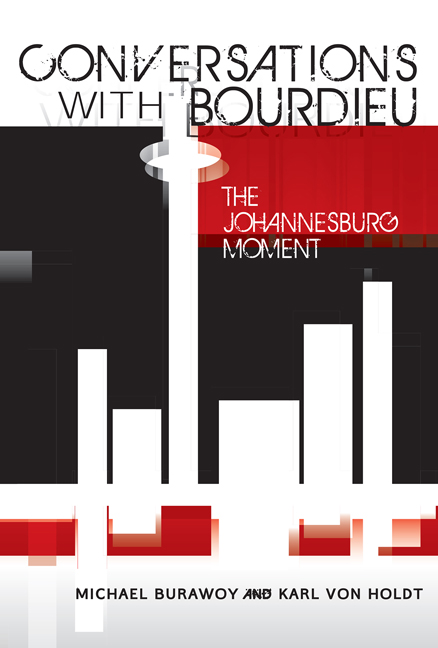Book contents
- Frontmatter
- Contents
- Abbreviations and acronyms
- Preface
- Prologue The Johannesburg Moment
- Acknowledgements
- CONVERSATION 1 SOCIOLOGY AS A COMBAT SPORT
- CONVERSATION 2 Theory and Practice
- Marx Meets Bourdieu
- Bodies of Defiance
- CONVERSATION 3 CULTURAL DOMINATION
- CONVERSATION 4 COLONIALISM AND REVOLUTION
- CONVERSATION 5 PEDAGOGY OF THE OPPRESSED
- CONVERSATION 6 THE ANTINOMIES OF FEMINISM
- CONVERSATION 7 INTELLECTUALS AND THEIR PUBLICS
- CONVERSATION 8 MANUFACTURING DISSENT
- Epilogue Travelling Theory
- Bibliography
- Index
Bodies of Defiance
from CONVERSATION 2 - Theory and Practice
Published online by Cambridge University Press: 20 April 2018
- Frontmatter
- Contents
- Abbreviations and acronyms
- Preface
- Prologue The Johannesburg Moment
- Acknowledgements
- CONVERSATION 1 SOCIOLOGY AS A COMBAT SPORT
- CONVERSATION 2 Theory and Practice
- Marx Meets Bourdieu
- Bodies of Defiance
- CONVERSATION 3 CULTURAL DOMINATION
- CONVERSATION 4 COLONIALISM AND REVOLUTION
- CONVERSATION 5 PEDAGOGY OF THE OPPRESSED
- CONVERSATION 6 THE ANTINOMIES OF FEMINISM
- CONVERSATION 7 INTELLECTUALS AND THEIR PUBLICS
- CONVERSATION 8 MANUFACTURING DISSENT
- Epilogue Travelling Theory
- Bibliography
- Index
Summary
Bourdieu is interested in the subordinated body that the subaltern habitus predisposes to manual labour, as well as to deference, humility and a physical stance of submission. This immediately poses the question of the body in resistance. The body on strike is already a body of defiance, refusing the routines of subordination and of the supervisor's instruction, disrupting authority. Striking workers today chant songs with their roots in the freedom songs of the 1980s, dance the toyi-toyi war dance that originated in the military camps of Umkhonto we Sizwe, and carry sticks that they understand to symbolise acts of fighting or war.
Where does this – the refusal, the defiance – fit into the idea of habitus, which predisposes the dominated to find domination invisible and submit to it? Nor does the body of resistance only come into being at the moment of explicit collective mobilisation. In my study of workers’ struggles at Highveld Steel in the apartheid era, workers talked about a continual resistance to the pace of white managers and their machinery, about an ‘apartheid go-slow’ on the part of African workers. Workers at the Daimler-Benz plant in East London wore wooden AK-47s strapped to their bodies on the production line, symbolising the connection between their struggles and the military struggle of the African National Congress (ANC), while supervisors locked themselves in their offices (Von Holdt, 1990). Can Bourdieu's theory account for the resistant body, the body that refuses the machinery and structures of domination?
According to Bourdieu (2000 [1997]: 182), historical critique is ‘a major weapon of reflexiveness’ which ‘makes it possible to neutralise the effects of naturalisation’. For Bourdieu, it is the scholar who has the time and occupies a location that makes it possible to pursue this task. The first strike I went to after arriving in Johannesburg in 1986 was an occupation strike in a big engineering works. Hundreds of workers were gathered in a solid and disciplined phalanx, toyi-toying slowly up the main roadway between the factory buildings. Many were bearing cardboard shields and steel replicas of spears turned on factory lathes, and in front of them whirled and danced two of the strike leaders, their factory overalls supplemented with animal furs and beads, referencing pre-colonial culture and resistance to colonial conquest.
- Type
- Chapter
- Information
- Conversations with BourdieuThe Johannesburg Moment, pp. 46 - 50Publisher: Wits University PressPrint publication year: 2012



